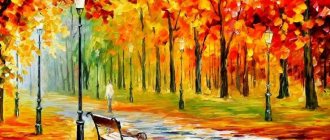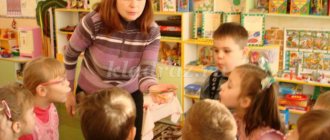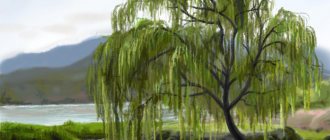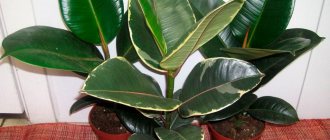Article Summary of the lesson “Ecological trail”. Author: Sadova Valentina Viktorovna
Lesson summary "Ecological trail"
Goal: Enrichment and systematization of environmental knowledge among preschool children using the ecological trail of a preschool educational institution. Tasks:
- Raising a child’s conscious attitude towards the environment through communication with nature
Ouch ; -Development of aesthetic feelings (the ability to see and feel the beauty of nature, admire it, the desire to preserve it);
The stops of the ecological trail are: 1. “Beryozka”
2. “Beautiful Christmas trees” 3. “Merry birdhouse”
4. "Terem-Teremok"
5. "Green Pharmacy"
6. “Flower - seven-colored” Lesson progress: - Educator: Guys, do you like to travel? Today we will go on an amazing journey. - Do you know what a path is? (Children's answers). That's right, a path, a path, is a walking path. What do you think an ecological path is? (Children's answers are listened to.) The ecological path consists of certain stations, and at each of them there live natural plant creatures: herbs, trees, shrubs; animals: spiders, insects, birds. You can walk along this path more than once. We will travel along it all year round.
— Today we have very interesting stations waiting for us on our trail. Well, let's hit the road?!
1 Station : “Beryozka” Educator: Here we are. Let's say hello. She was waiting for us and prepared a letter, let's read and fulfill the wishes and tasks of the birch tree. - Do you agree? (Yes) Letter from the birch tree: “My dears, you have finally come to me. How I waited for you, how I shook the branches, rustled the leaves, hoping that you would hear me. I, birch, am very happy about your arrival, because I love guests very much. Let's say hello: hug me tightly (children hold hands around the trunk). I like to be stroked, and I don’t like when the trunk is hit with a stick or the bark is scratched. I feel hurt and offended when people treat me badly. Touch me with your hands, stroke my bark-skin with your hands and tell me how rough or smooth it is? Wet or dry? Warm or cool? What do I smell like? (Children fulfill these requests too.) - Now, answer my question: what is it that holds me so tightly in the ground? (Children answer.) - Why else do I need my roots and legs? (To take water, “food” from the ground.) - Thank you, guys. Well done. Now stand and listen to how my leaves rustle - I’m talking to you. What did I just say? (Children express their assumptions.) Why are my leaves moving? Well done, my glorious travelers. Don't forget about me"
Station 2: “Christmas trees are beautiful”
A slender beauty dresses up in pine needles, In hot summers and in snowstorms She loves the color of green spruce. Educator: - Guys, let's look at the spruce, the spruce trunk is straight, the bark is reddish-brown. The crown looks like a cone (triangle). Branches with dense needles begin close to the ground. Spruce trees have needles instead of leaves; they are stored for the winter. Arrangement of branches: young, short at the top, long at the bottom, old, wide. The tree has a very pleasant spruce smell. Spruce coniferous tree. All spruce branches are covered with needles that grow instead of leaves; the needles are short, sharp, prickly, dark green in color, covered with dense skin, sit thickly and firmly on the eyelid, stick out to the sides, and do not fall off if touched. -Who can offend a spruce tree, and how can we help it? A very strong wind can break the trunk, branches, and uproot the tree from the ground. If there is little snow, the spruce and its roots may freeze in the frosty winter. A person can damage a spruce tree if he cuts the trunk with a knife or breaks branches if he plans to cut it down for the New Year holiday. You can help the spruce tree: dig snow to the trunk to make it warmer, carefully shake off the heavy snow from the branches, handle it with care.
-Questions: – What type of tree is spruce? (coniferous) - What are the needles on spruce called? (needles) - What is the name of the forest where only spruce trees grow? (spruce forest) What benefits does spruce bring? — supplies wild animals and birds with cones and seeds; — cleans the air of harmful substances and impurities; — releases oxygen all year round; - in summer it serves as a source of coolness and shade; - Well done! Answered all my questions. While we move on, let's play?!
Didactic game “Fruits and Vegetables” I’ll see who’s clever here... We raise our hands higher If I tell you a vegetable. If I name a fruit, quickly put your hands on the grass!
(potatoes, apricots, carrots, cabbage, apples, peppers, pears, cucumbers, zucchini, onions, grapes, beets, peach, plums, radishes).
Station 3: “The Cheerful Birdhouse” The teacher offers to guess the riddle: There is a new house between the branches, There is no door in that house, Only a round window, Not even a cat can get through. (Birdhouse) Questions: - What is a birdhouse? (children's answers) - Where did he come from on our site? (children's answers) - For whom did the person make the birdhouse? (children's answers) - Let's remember what we know about this bird? (children's answers) - Guys, when can you hear the voices of starlings? (children's answers) - Yes, the singing of a starling can be heard in the summer. Why can’t you hear a starling in winter? (children's answers). -Yes, starlings fly to warmer climes for the winter, because they cannot tolerate such severe frosts as we experience in winter. Before leaving, the starling flies to his house and starts a beautiful farewell song. - What do you think will happen to the empty birdhouse? (children's answers) - After the starlings fly away, their house will be occupied by other birds that will stay with us for the winter (sparrows or titmice).
Educator: Well done! In the meantime, we move on, try to guess my riddles about vegetables: 1. They buried them in the ground in May and didn’t take them out for a hundred days, but they started digging in the fall. They found not one, but ten. - potatoes - 2. The goat says that goats really like to smell roses. But for some reason she sniffs with a crunch... - cabbage - 3. An orange root sits underground, It stores a storehouse of vitamins, Helps children become healthier, What kind of vegetable is this, can you tell? - carrots - 4. Above the ground there is grass, Under the ground there is a burgundy head. - beets - 5. He never offended anyone in the world. Why do both adults and children cry from him? - onion - 6. It grows very long and takes up half the bed. This vegetable is pumpkin brother, everyone eats it in summer. - zucchini - 7. Green branches grow in the garden bed, and on them are red children. - tomatoes - 8. I am long and green, I am tasty salty, Tasty and raw. Who am I? - cucumber -
4 Station: “Terem-Teremok”
Educator : We will make our next stop around the stump. Who knows what a stump is? (Children's answers.) Look, there was once a tree here, then it was cut down. A stump remained in place of the tree. Do you think anyone lives on a stump? (Children's answers.) Life also goes on in this stump. Small insects and bugs hide in the stump. Name the insects you saw on our site. (Children's answers.) They climb into a stump and stay there all cold winter - this is their home. A grass, a flower, and even a tree can grow from a stump and start a new life. Children look at the stump.
5Station: "Green Pharmacy"
Educator: - Today, guys, I invite you to visit the “Green Pharmacy.” — Guys, what is a pharmacy? (This is where they sell medicines, tablets, vitamins, ointments, bandages, cotton wool...) - Correct! What is a “Green Pharmacy”? How do you think? Children: They probably sell medicinal herbs there. - Right! And today I will tell you what medicinal plants can be found in a green pharmacy! — The first plant I want to tell you about is called Mother and Stepmother. - Guys, let's take a closer look at this plant. What parts does this plant have? (root, stem). Gently touch the stem, what is it covered with? (light fluff). Why do you think a plant needs fluff? (protects the plant from cold). What other parts does the plant have? (leaves). Place your palm on the sheet, look, guys, the sheet covered your entire palm. So, what size are the leaves of this plant? (large, large). - Why is this plant called coltsfoot? (Children's answers.) -Guys, stroke the bottom of the sheet. How do you feel? (soft, warm). As if my mother had caressed me. Now stroke the top of the sheet. What is she like? (smooth, cold). People say “like a stepmother.” That's why the plant is called coltsfoot. This plant will help cure bronchitis and pneumonia in sick patients, and treat cough. In order to prepare medicine from this plant, you need to pick the leaves, wash them and pour boiling water over them, and then, when the decoction is infused, strain and give it to the patient. — The next plant I want to tell you about is called Plantain.
- Let's see, do you know this plant? How did you recognize him? (by leaves). Touch them, what do they feel like? (elastic, with strong, like nylon veins). What are the shape of the leaves? (oval). — Plantain, guys, heals wounds. — Plantain decoction treats throat diseases. Chamomile also heals throat diseases , listen to the poem: When my throat hurts, Chamomile will help, it will heal. I’ll gargle my throat with it. Everything will be fine, and I’ll go to kindergarten. Educator: What can you say about her? (Chamomile grows everywhere: in a meadow, in a clearing, near a river, it has a short, straight stem, thin, branched, the leaves look like dill, the flowers are small and there are many of them, white petals and a yellow center.) -People collect chamomile flowers and dry them They are used to prepare a decoction that is used to gargle with sore throat, stomatitis, etc. — The last plant I’ll tell you about today is called Clover . “Moo,” the calf moos in the morning, “Clover gives me strength.” I’m in the meadow without him and I can’t go a day. — People use grass, flowers, plant roots, which are harvested in the summer, during its flowering. The leaves of the flowers are cut and then dried in the shade, after which they are used to prepare healing infusions and decoctions that are used externally for skin diseases, for example, psoriasis, eczema (childhood), diathesis. It is taken orally for the complex treatment of malaria and rheumatism. Used for urolithiasis, bleeding, anemia. — Guys, today we met some of the plants of the “Green Pharmacy”, what plants are they? (children's answers) - In fact, there are many more different plants in the “Green Pharmacy”.
6 Station: “Flower - seven-flowered” (flower bed) Smart little sisters greet guests all day and treat them to honey. (flowers) - What time of year is it now? — What happens to plants in summer (autumn)? —What helps flowers grow? (Sun, rain, earth, insects and people.) - What is the name of the profession of a person who grows flowers? (florist) -Why do people create flower beds? (Flower beds decorate the city and delight the residents.) - How should you care for a flower bed so that it always pleases with beautiful flowers? (Weeding, loosening, fertilizing, proper watering. Under no circumstances should you water flowers under the scorching sun, as this can cause them to burn; it is better to do this in the morning or evening.). Is it possible to pick them from flower beds? — Guys, flowers are annual and perennial. — Annual flowers are those that live from spring to autumn, for example, asters and marigolds; Perennial flowers are those that live and bloom for more than two years, for example: rose, astilbe, narcissus, hosta, lily. -. Many poems have been written about flowers. Listen to the poem: “Pansies are flowers from a fairy tale, they are colorful in the green grass. Pansies are colorful flowers, and their eyes are full of sunny caress.” —What flower is the poem talking about? - “Pansies” also grow in our flowerbed, let’s look at them, what color and shape the petal, leaves, stem, short or long stem are. — In our flowerbed there are also petunias (annual), marigolds (annual), ornamental grass sedge (perennial), hosta (perennial). The teacher and the children examine familiar flowers in the flowerbed.
Our journey has come to an end. Did you like it? What new have you learned?





